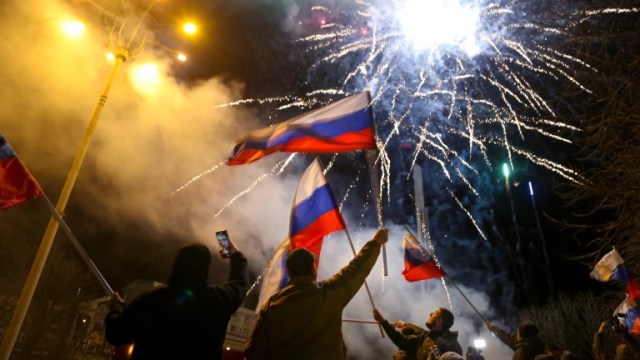
Who has followed Russia in recognising the controversial, Moscow-backed statelets in Ukraine? And what is life like there?
By Aljazeera – Mansur Mirovalev
Feb 22, 2022
Moscow-backed separatists have controlled the southeastern Ukrainian regions of Donetsk and Luhansk, known collectively as Donbas, for almost eight years.
But Russian President Vladimir Putin recognised them only on Monday, paving the way for the official presence of Russian troops in the rebel-controlled areas that occupy about a third of Donetsk and Luhansk.
So far, only Cuba, Venezuela, Nicaragua and Syria have joined Putin in recognising Donetsk and Luhansk – along with breakaway Georgian provinces of South Ossetia and Abkhazia. They all did so also on Monday.
The central question is whether Russia would recognise them in their current borders. Should it decide to help the rebels “restore” their statelets to the original borders, it may spell a large-scale war between Moscow and Kyiv.
At the moment, Russia will recognise “the borders, where the leadership of the DNR and the LNR are executing their authority,” Deputy Foreign Minister Andrey Rudenko told the Interfax News Agency on Tuesday.
But the foreign ministry also said on Tuesday that the issue of the borders is yet to be resolved.
While Ukraine and the West try to avoid war, other questions loom.
What are the roots of the region’s separatism? What has kept these areas alive since 2014? And what is their future?
Neo-Stalinism
A 13.5 metre-tall statue of Soviet founder Vladimir Lenin still dominates the main square in Donetsk, the capital of the eponymous breakaway region in southeastern Ukraine.
And the constitution adopted by Lenin’s successor, Josef Stalin, has been restored by the Moscow-backed separatist leaders of Donetsk and neighbouring Luhansk after they broke away from the central government in 2014.
This constitution prescribes the death penalty for a number of crimes, making the separatist “People’s Republics” – and authoritarian Belarus nearby – Europe’s only homes to capital punishment.
After almost eight years of existence, the “republics” are understood to have evolved into totalitarian, North Korea-like statelets.
It is near impossible for foreigners to enter the areas. Ukrainians can only visit if they have relatives in Donetsk and Luhansk, and would have to cross into Russia first, which takes about 30 hours and costs $100 – a journey that also involves bribing officials at times. Residents need a Soviet-era residency registration.
In the statelets, secret police and “loyal” residents monitor every word, phone call and text message.
Dissidents or businessmen who refuse to “donate” their assets to the “needs of the People’s Republic” have been thrown in “cellars”, or dozens of makeshift concentration camps, without trial.
“It looks like the 1930s in the Soviet Union, a classic gulag,” Stanislav Aseyev, a publicist who was kidnapped in 2017 in Donetsk and was sentenced by a separatist “court” to 15 years in jail for “espionage”, told Al Jazeera.
For almost two years, he was incarcerated and tortured in these “cellars” until separatists swapped him and dozens of other prisoners in 2017.
Thousands of others were tortured and abused in the “cellars”, according to rights groups and witnesses. The grave human rights abuses make Donetsk and Luhansk far worse than today’s Russia, an international human rights advocate said.
“The cellars where prisoners are held in Donetsk, and the widespread use of torture, are among the most obvious human rights issues,” said Ivar Dale, a senior policy adviser with the Norwegian Helsinki Committee, a human rights watchdog group.
But there are much wider problems such as civil and political rights, he said.
“You could say that the political repression in Russia is doubly felt in Donetsk and Luhansk and other areas effectively under control of the Putin regime,” Dale told Al Jazeera.
Rust-belt ruins
These tendencies have gone hand in hand with economic degradation.
The living standards are “many times, if not dozens of times worse than in pre-war 2013”, said Aseyev, 32, who now lives in Kyiv and has published a novel about the events in Donetsk.
This regress looks even more staggering considering Donetsk’s and Luhansk’s not-so-ancient history. The cities were founded by two Brits.
Englishman Charles Gascoigne built a metal factory in what is now Luhansk in 1795, shortly after czarist Russia annexed Crimea and eastern Ukraine from the Crimean Khanate, a mostly-Muslim vassal of Ottoman Turkey.
Decades later, in 1869, Welshman John Hughes started a steel plant and a coal mine in what is now Donetsk, and the city was named after him – Hughesovka or Yuzovka – until the Soviet era.
The birth and rapid growth of both cities followed the czarist government’s drive to develop the immense coal and iron ore deposits of what is now eastern Ukraine.
Communist Moscow further spurred the region’s development, and tens of thousands of ethnic Russians settled there, making urban areas almost exclusively Russian-speaking.
…
Read More: Aljazeera – Donetsk and Luhansk: What you should know about the ‘republics’
…

